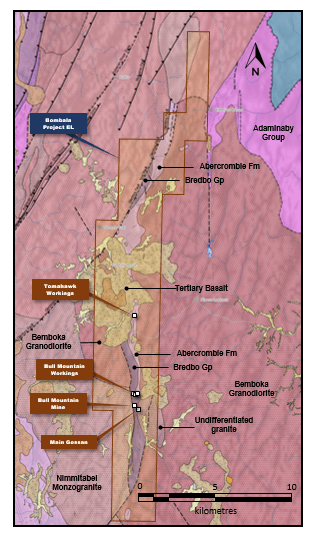- The Bombala Au-Cu Project is located north of Bombala township and is an early is an early-stage regional exploration play for Volcanic Hosted Massive Sulphide mineralisation in a geological setting akin to the Woodlawn and Captains Flat volcanogenic massive sulphide deposits in the eastern LFB.
- Exploration to date has identified multiple prospects and significant mineralization intersected in historical drilling:
- BMRC03: 29m @ 0.32 g/t Au, 0.14% Cu from 40 to 69m (incl. 2m @ 1.0 g/t Au from 52m);
- BMRC06: 36m @ 0.48 g/t Au, 0.08% Cu from 65 to 101m (incl. 4m @ 1.0 g/t Au from 67m);
- BMRC08: 26m @ 0.50 g/t Au, 0.12% Cu from 85 to 111m (incl. 4m @ 1.2 g/t Au from 85 m); and
- BMRC01: 20m @ 0.18% Cu from 46 to 66m (incl. 2m @ 0.6% Cu from 52m).
The main zone of exploration interest for Revolution consists of a narrow belt up to 2 km wide (but mostly about 500 m) of Late Ordovician to Silurian acid to intermediate volcanics and metasediments (Bredbo Gp & Abercrombie Fm) that lie along a faulted contact of the Glenbog Granodiorite to the west and the Bukalong Granite to the east. Tertiary basalt flows lie unconformably over the older rocks and cover the tops of many of the hills in the Brown Mountain area. A large basalt outlier sits over the top of the prospective Ordovician-Silurian rocks at the granite contact zone in central part of EL.
- An area of linear gossan outcrops, associated with several small mine workings containing siliceous alteration and veining, are present within the Late Ordovician to Silurian acid to intermediate volcanic and metasedimentary sequence in the southern portion of EL.
- Massive sulphide consisting of pyrite with associated copper, lead, zinc, gold and pyrrhotite has been exposed at the base of old workings in the volcaniclastic unit. The sulphide mineralisation is accompanied by chlorite-sericite-quartz alteration of the host rocks. This may be associated with volcanic-hosted massive sulphide (VHMS) mineralisation similar to Woodlawn.
- Alternative economic mineralisation models for the area indicate prospectivity for porphyry-epithermal gold-copper mineralisation and/or shear-hosted gold mineralisation hosted by Ordovician volcanic and subvolcanic rocks of alkaline affinity.

